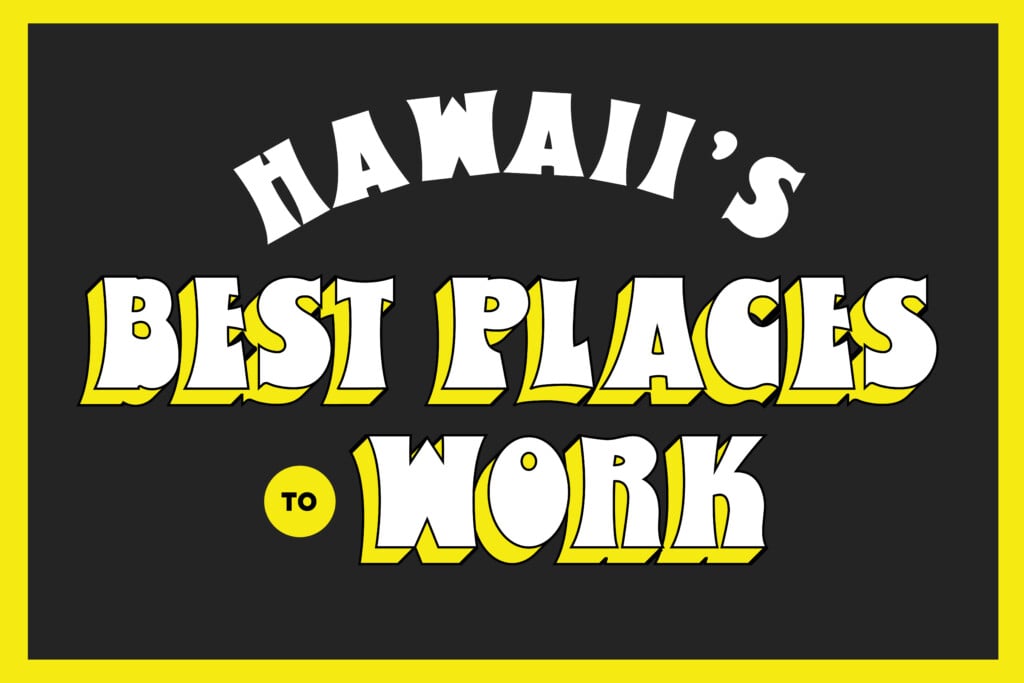
Hawai‘i’s Best Places to Work 2024
Hawai‘i’s Best Places to Work 2024: 78 Companies That Made the Cut Find out who led the way in 14 categories, and how two organizations attract and keep employees despite serious challenges. APRIL 8, 2024 CYNTHIA WESSENDORF Large Companies | Medium Companies | Small Companies | Other Categories | Hall of Fame Businesses nationwide are contending with widespread disenchantment about work, and engagement levels are stuck at 33%, according to a Gallup survey. The vast majority of employees say they’re not happy in their jobs and they’re just doing the bare minimum, or less. There’s no quick fix or secret formula for building an energized, committed workforce. But there are lots of ways to erode the bond between employer and employee, and it often starts at the top. Michael Kamaka, VP at Bowers + Kubota, says it succinctly: “When it comes to employees, if you don’t care about them, they’re definitely not going to care about you.” The companies and nonprofits on Hawai‘i’s Best Places to Work 2024 list strive to create better experiences for everyone, according to surveys of employees and company representatives by the Texas-based Workforce Research Group, Hawaii Business Magazine’s partner on the project. Employees at these companies say they’re highly satisfied with their jobs, managers, co-workers and company culture, according to survey responses, and they’re overwhelmingly positive when responding to prompts such as: This organization treats me with dignity, not as just a number. I am part of a team with a common purpose. This organization actively promotes diversity and inclusion. I believe in this organization’s leadership. I intend to remain at this organization for the foreseeable future. So what are these companies doing differently? How do their core principles, practices and benefits translate into employees who feel genuinely heard and valued, and who, in return, do their best work? Two Best Places to Work, Bowers + Kubota and Parents And Children Together, rank first and third in the large companies category, and they’ve consistently performed well for over a decade. Despite being very different organizations – one is an architecture and engineering firm, the other a social services nonprofit – there are some striking, and instructive, similarities. Both Started Small and Have Stayed True to Their Roots. Bowers + Kubota launched as a tiny firm in 1980, and has since grown to nearly 300 employees across the Islands. As it’s grown in size, potentially burdensome processes and procedures have expanded as well. “But we don’t want to become bureaucratic,” says Brian Bowers, president of Bowers + Kubota. “I’m proud that we’ve been able to maintain this family-centric, nimble organization that really puts the employees first.” In 1968, Parents And Children Together started as a grassroots organization dedicated to improving life at Kuhio Park Terrace, now called the Towers of Kuhio Park, in Kalihi. Today, with a staff of more than 300, the nonprofit stays focused on the mission. “We started as a community group that collectively came together to work on solving problems,” explains Ryan Kusumoto, president and CEO of PACT. “That foundation helps keep us going. Nothing we do happens in a vacuum … but involves listening to the community. In terms of our workplace, it means listening to your staff.” Both Face Industrywide Challenges Finding and Keeping Employees. Today, Bowers + Kubota confronts an ongoing workforce shortage, which means it’s competing for a small pool of engineers and other skilled professionals. Those potential hires have plenty of other job opportunities, with enticing salaries and benefits packages. Parents And Children Together competes for talent too, and in a notoriously difficult field. Nationally, 4 in 10 employees in the social services sector leave their jobs every year, says Kusumoto, often the result of burnout from working with clients in crisis. Like Bowers + Kubota, PACT also struggles with a shortage of highly educated and licensed professionals, especially in areas such as mental health and early learning. Both Focus on Their People, in Ways That Go Beyond Lip Service. To attract employees and get them to stay, the organizations have to distinguish themselves. They do it by working to create warm, collaborative cultures. “The managers and leadership realize that the company’s biggest asset are the people. Everything we do follows that mantra. We have to take care of our people,” says Kathleen Chu, VP at Bowers + Kubota. The company organizes mentoring opportunities, social events, volunteering activities and more to help employees feel connected to each other. At family events, top executives make sure they talk to everyone, and they visit employees in the hospital when they’re sick. “ At the end of the day, anyone can get a job with more pay and more benefits. But I don’t think you get the same camaraderie,” Kamaka says. “We have teams that are fiercely loyal to each other. They’ll do whatever it takes to help each other out. I think that connection is what people like.” At PACT, Kusumoto says he focuses on belonging, which is a more meaningful measure than employee engagement. “When we focus on the word belonging, we think about how to get that deep connective tissue with our employees,” he explains. It starts at the beginning of the relationship, by hiring people who share PACT’s values. “When you come to work for us, it’s because you care about this community,” he says. “We’re not here to tell people what to do. We’re here to walk alongside individuals and help them get to the place they need to be.” He also gives new employees his cellphone number, with instructions to call or text at any time. “I want to hear their stories because that helps make me be better,” Kusumoto says. “Just saying you have an open-door policy is not enough. You have to be intentional about it.” Both Rely on Employee Surveys to Continually Improve. Bowers + Kubota participates in both the Hawai‘i Best Places to Work survey and a national industry-specific survey. The senior management team reviews all the responses, publicly answers employees’ questions and follows up with specific actions to address problems. For example, after getting feedback from younger employees who were struggling with Hawai‘i’s housing costs, Bowers + Kubota rolled out a pay raise. The company also started to hold “rap sessions” between employees and managers to get people talking and sharing more. “We’re always looking for that edge and to improve our policies and practices,” Bowers says. “Whether it’s quantitatively or qualitatively, you always want to be growing in some way as a company because if you’re not moving forward, you’re probably moving backwards.” PACT also scours the annual Best Places survey for new ideas and to see what’s working or not. Based on employee feedback, it initiated all-gender bathrooms and formed affinity groups that encourage open dialogue among staff. And it started up an extremely low-interest microloan program to help people deal with emergencies such as car breakdowns and medical expenses. The nonprofit introduced monthly online meetings that gather staff from across the Islands for information sharing and special speakers. And it expanded its wellness programs and training on how to handle difficult issues, such as suicide prevention. Both Splurge on Benefits They’re Best Able to Offer. Bowers + Kubota offers a suite of benefits, such as competitive salaries, fully paid family medical insurance and a 401(k) plan with a company match. But the company goes much further to let employees know they matter: In 2012, it launched an employee stock-ownership plan, or ESOP, which is fully funded by Bowers + Kubota. Every employee is a shareholder, and they can withdraw their funds or roll them over into IRAs when they leave. “We’ve had people leave after only 10 years with literally hundreds of thousands of dollars in their retirement accounts,” Bowers says. Human resources expert and Bowers + Kubota principal Amy Matsushima leads staff in elaborate role-playing games so that people understand how an ESOP works, and how their actions affect share price. “The concept can be a little challenging at first, but when they see that first statement, it starts to click into place,” she says. At PACT, which largely operates from state and federal contracts, Kusumoto says the biggest financial challenge is making sure it can pay people competitive salaries without cutting the quality of services. The organization applies for grants, hosts fundraisers, and advocates for higher payments from state contracts, which have remained stagnant for a decade. To improve the overall compensation package, people are given lots of paid time off to decompress and rejuvenate. Employees get 21 days of vacation; 12 sick days, of which five can be used for personal days off; and 14 days for holidays. That’s eight full weeks away from the job each year, plus extra days for sick leave. “Our staff are dealing with individuals with mental illness, they’re dealing with the child welfare system, with domestic violence, with poverty. They’re carrying the weight of the clients we service, so it’s really tough,” Kusumoto says. “We don’t blink an eye with regards to the amount of days we give off,” he says, “because we know that when people come to work, they work.”

How to Leverage Technology when buying or Selling
In today's fast-paced digital world, technology has become an integral part of our everyday lives. From shopping online to managing our finances, it has revolutionized the way we interact and conduct business. Real estate is no exception to this digital transformation. Whether you are buying, selling, or investing in properties, leveraging technology can significantly enhance your experience and outcomes. In this blog, we will explore how you can harness the power of technology to streamline the process and make informed decisions.Buyers:As a buyer, technology offers a wealth of resources and tools at your fingertips. Online property portals and listing websites provide you with a vast array of options, enabling you to browse through properties from the comfort of your home. These platforms offer detailed information, including property descriptions, high-quality images, virtual tours, and even 3D models in some cases. By taking advantage of these features, you can save valuable time by initially eliminating properties that don't meet your criteria.Additionally, technology has made it easier to connect with real estate agents and schedule property viewings. Virtual meetings and video conferencing tools allow you to communicate with agents in real-time, discuss your requirements, and receive personalized recommendations. Furthermore, digital document signing platforms simplify the paperwork involved in the purchasing process, eliminating the need for physical meetings and enabling you to complete transactions swiftly and securely.Sellers:For sellers, technology has transformed the way properties are marketed and showcased to potential buyers. Virtual staging has emerged as a game-changer, allowing sellers to present their homes in the best possible light. By digitally furnishing and decorating vacant spaces, sellers can create engaging visuals that appeal to buyers' preferences, helping them envision the property's true potential. This can significantly increase the likelihood of attracting more interested parties and even receiving higher offers.Moreover, social media platforms have become powerful marketing tools for sellers. By leveraging platforms like Facebook, Instagram, and YouTube, sellers can reach a wider audience and generate interest in their properties. Engaging content such as high-quality images, videos, and virtual tours can capture the attention of potential buyers and encourage them to explore further.Investing:Technology has also revolutionized the way real estate investors conduct research and evaluate potential opportunities. With the availability of extensive data and analytics, investors can now make data-driven decisions rather than relying on guesswork. Online platforms provide access to historical property prices, rental yields, market trends, and even predictive analytics, empowering investors to identify areas with high growth potential and favorable investment conditions.Furthermore, crowdfunding platforms have emerged as a popular avenue for real estate investment. These platforms allow individuals to pool their resources and invest in larger-scale projects that were traditionally only accessible to institutional investors. With just a few clicks, investors can diversify their portfolios and gain exposure to different types of properties across various markets.In conclusion, technology has transformed the real estate industry, offering countless benefits to buyers, sellers, and investors alike. By leveraging technology, buyers can easily explore properties, connect with agents, and complete transactions efficiently. Sellers can utilize virtual staging and social media marketing to attract more interested buyers. Investors can access vast amounts of data and diversify their portfolios through online platforms. Embracing technology in real estate is no longer an option but a necessity in this rapidly evolving digital landscape. So, whether you are buying, selling, or investing in real estate, make sure to embrace the power of technology to maximize your outcomes and stay ahead in the game.
Tour Honolulu's Cultural Sites
Honolulu, Hawaii is a vibrant city known for its breathtaking natural beauty, warm tropical climate, and rich cultural heritage. As a real estate hotspot, Honolulu offers a wide range of properties for buyers and sellers alike. In addition to its stunning beaches and iconic landmarks, the city is also home to numerous cultural sites that showcase its diverse history. Join us as we take a tour of some of Honolulu's most notable cultural attractions, and discover why this city is a haven for both residents and tourists.For prospective buyers, Honolulu offers a unique opportunity to own a piece of paradise. The city boasts a diverse real estate market, ranging from luxurious oceanfront properties to cozy inland homes. Whether you're looking for a modern condo in the heart of downtown or a charming bungalow in a quiet neighborhood, Honolulu has something to suit every taste and budget. The city's cultural sites add an extra layer of appeal, as they provide residents with a deeper connection to the local community and its history.One of Honolulu's most famous cultural sites is the Iolani Palace. Built in 1882, it served as the official residence of the Hawaiian monarchy until the overthrow of the kingdom in 1893. Today, the palace stands as a symbol of Hawaii's rich heritage and is open to the public for tours. Visitors can explore the opulent interiors, filled with historical artifacts and exquisite craftsmanship, and learn about the fascinating history of the Hawaiian monarchy.Another must-visit cultural site in Honolulu is the Bishop Museum. Founded in 1889 by Charles Reed Bishop in honor of his late wife, Princess Bernice Pauahi Bishop, the museum is dedicated to preserving and sharing the history and culture of Hawaii and the Pacific. With a vast collection of artifacts, artwork, and natural history exhibits, the Bishop Museum offers a comprehensive overview of the region's diverse cultural heritage. From traditional Hawaiian canoes to ancient Polynesian artifacts, the museum provides a fascinating glimpse into the past.For sellers in Honolulu, highlighting the city's cultural sites can be a valuable asset. Potential buyers are often drawn to properties with a strong sense of community and a connection to the local culture. By emphasizing the proximity of these attractions and the unique experiences they offer, sellers can make their properties even more enticing. Living in close proximity to cultural sites allows residents to immerse themselves in the vibrant arts and traditions of Honolulu, enhancing their overall quality of life.Aside from the cultural sites themselves, the neighborhoods surrounding them also hold their own appeal. For instance, the historic district of Chinatown is not only home to a vibrant arts scene but also offers a wide range of dining and shopping options. With its eclectic mix of traditional Chinese temples, art galleries, and trendy boutiques, Chinatown is a hotspot for both locals and tourists. Living in the vicinity of this bustling neighborhood allows residents to experience the energy and creativity that permeate its streets.Another neighborhood worth exploring is Kakaako, which has experienced rapid growth in recent years. Formerly an industrial area, Kakaako is now a thriving community known for its contemporary art scene, trendy restaurants, and upscale condominiums. With its proximity to downtown Honolulu and numerous cultural sites, Kakaako offers a convenient and vibrant lifestyle for those seeking a modern urban experience.In conclusion, Honolulu's cultural sites add a unique charm and value to the city's real estate market. Buyers can find their dream homes nestled among the diverse neighborhoods surrounding these attractions, while sellers can leverage the cultural richness of the city to enhance the appeal of their properties. Whether you're captivated by the history of Iolani Palace or drawn to the contemporary art scene in Kakaako, Honolulu offers a wealth of cultural experiences that make it a truly special place to call home.


